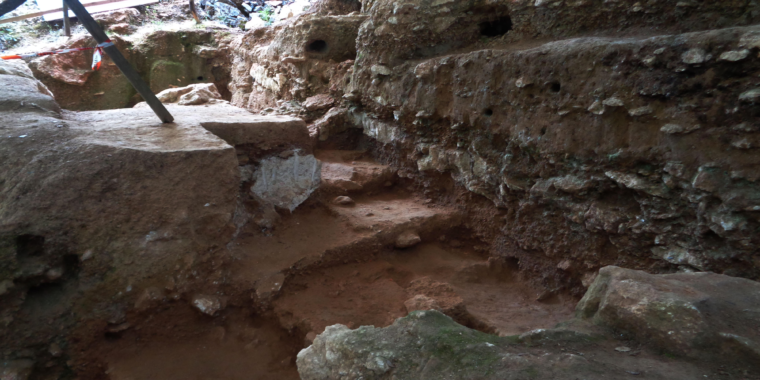Not the kind of fiber Ars usually covers –
We have no proof Neanderthals told stories, but they definitely spun yarns.
When Kenyon College archaeologist Bruce Hardy and his colleagues looked at the thread under a microscope, the fibers turned out to be from bast: a fibrous layer of tissue just beneath the bark of a tree. These particular fibers had probably come from a conifer like pine, which would have been available nearby, according to pollen and charcoal traces from the site. An ancient craftsperson had twisted fibers together clockwise to make twisted bundles and then twisted three bundles together counterclockwise to make a three-ply cord. The cord was about 0.5mm thick (lace weight, if you’re a modern knitter or crocheter).
a) SEM photo of ancient thread fragment from Abri du Maras; (b) 3D Hirox photo of the thread fragment; (c) schematic drawing of the thread fragment; s-twist sections are the clockwise-twisted bundles of individual bast fibers, and z-twist sections are the counterclockwise-twisted plies, made up of several bundles twisted together; (d) enlarged Hirox photo with cord structure highlighted.
Hardy et al. 2560
Compare the structure of the Abri du Maras thread to this close-up look at modern flax cordage.
S. Deryck
Approximately
The fiber find suggests that Neanderthal life included a lot more than stone and bone tools. Once you can twist or spin fibers into thread, you can make all sorts of things: clothes, nets, cord for fishing or hafting stone tools, and rope for all sorts of purposes. Those kinds of objects are, if you’ll excuse the pun, woven into the fabric of daily life, but the materials they’re made from decay quickly, so they’re almost invisible at Paleolithic sites like Abri du Maras. Archaeologists sometimes call wood and fiber artifacts “the missing majority,” and their absence can skew our ideas how about Neanderthals (and their eventual
The find also proves, yet again, how much Neanderthals were capable of. Just getting the bast fibers and preparing them to start making cord was a complex process that required quite a bit of knowledge:
“The best times for harvesting bast fibers would be from early spring to early summer. Once bark is removed from the tree, beating can help separate the bast fibers from the bark, ”wrote Hardy and his colleagues. “Soaking [the fibers] in water aids in their separation and can soften and improve the quality of the bast. The bast must then be separated into strands and can be twisted into cordage. ”
Bundling fibers and then plying bundles into cord, Hardy and his colleagues argue, also meant that Neanderthals could think about and work with numbers, and with numerical concepts like pairs and sets, which they combined to make a structure (the thread). And as any modern fiber artist knows, most of what you can do with the fiber afterward also requires at least a basic understanding of counting, sets, and patterns. And hands-on work with numbers, like counting fibers and bundles, may have been the first step in the evolution of the cognitive ability to do more advanced, abstract math. That’s the argument advanced in by Oxford University archaeologist Lambros Malafouris.
Once they had made the thread, working with the fiber required — and probably encouraged — even more complex thinking. “As the structure becomes more complex (multiple cords twisted to form a rope, ropes interlaced to form knots), it demonstrates ‘an infinite use of finite means’ and requires a cognitive complexity similar to that required by human language,” wrote Hardy and his colleagues.
In other words, Neanderthals were a long way from inventing algebra, but they obviously had a great grasp of string theory.
(Scientific Reports) , (DOI:) . / s 61839 – – – w ( About DOIs





GIPHY App Key not set. Please check settings